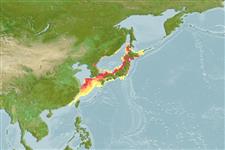Environment: milieu / climate zone / depth range / distribution range
Écologie
marin démersal; profondeur 15 - 269 m (Ref. 58496). Boreal
Northwest Pacific: Japan and the Sea of Okhotsk.
Taille / Poids / Âge
Maturity: Lm ? range ? - ? cm
Max length : 44.0 cm TL mâle / non sexé; (Ref. 56527); common length : 31.5 cm TL mâle / non sexé; (Ref. 56557); poids max. publié: 1.0 kg (Ref. 56527)
Épines dorsales (Total): 9 - 10; Rayons mous dorsaux (Total): 14-17; Épines anales 0; Rayons mous anaux: 13 - 16
Life cycle and mating behavior
Maturité | Reproduction | Frai | Œufs | Fécondité | Larves
External fertilization with internal insemination (Ref. 101419). This is also called 'internal gametic association' which describes another unique phenomenon of the reproductive process. In this phenomenon, the presence of the spermatozoa in the ovarian cavity is done through copulation, but the spermatozoa entry into the egg and subsequent fertilization only occurred externally when the eggs are spawned and came into contact with seawater (Ref. 101419).
Nakabo, T., 2002. Fishes of Japan with pictorial keys to the species, English edition I. Tokai University Press, Japan, pp v-866. (Ref. 41299)
Statut dans la liste rouge de l'IUCN (Ref. 130435)
Menace pour l'homme
Harmless
Utilisations par l'homme
Plus d'informations
RéférencesAquacultureProfil d'aquacultureSouchesGénétiqueElectrophoresesHéritabilitéPathologiesTraitementNutrientsMass conversion
CollaborateursImagesStamps, Coins Misc.SonsCiguateraVitesseType de nageSurface branchialeOtolithesCerveauxVision
Outils
Articles particuliers
Télécharger en XML
Sources Internet
Estimates based on models
Preferred temperature (Ref.
123201): 3.6 - 17.3, mean 12.9 °C (based on 37 cells).
Phylogenetic diversity index (Ref.
82804): PD
50 = 1.0000 [Uniqueness, from 0.5 = low to 2.0 = high].
Bayesian length-weight: a=0.00676 (0.00300 - 0.01523), b=3.17 (2.98 - 3.36), in cm total length, based on LWR estimates for this (Sub)family-body shape (Ref.
93245).
Niveau trophique (Ref.
69278): 3.6 ±0.4 se; based on diet studies.
Résilience (Ref.
120179): Très faible, temps minimum de doublement de population supérieur à 14 ans (Preliminary K or Fecundity.).
Fishing Vulnerability (Ref.
59153): Low to moderate vulnerability (34 of 100).
